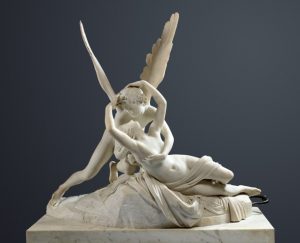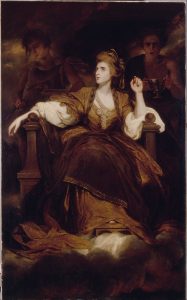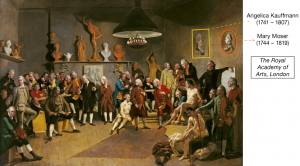1.5 Neoclassicism and the Late Neoclassical
The encyclopedia of art describes Neoclassicism as “yet another return to the Classical Orders of Greek and Roman Antiquity on a monumental level, albeit with the retention of all the engineering advances and new materials of the modern era.”
In France, the style began during the rule of The Sun King, King Louis the Xiv, and saw an explosion of design during the reign of Napoleon. The French wealthy classes reinterpreted neoclassicism when designing their private homes, by incorporating tropes like faux ruins, grottos, and fountains inserted into the landscape, while more experimental architects used it to design a range of civic structures.

Moving into the period of the enlightenment and neoclassicism, we witness a new form of sculpture and painting taking place, combining theatre, aesthetics, ideology, and commerce within a classical understanding of form. This was influenced by a German text written in 1755, and translated into English in 1765. Johann Joachim Winckelmann, (1765) claimed the beauty in classical sculpture was found in the understanding by the Greeks of sculpture as a living art being eternally relevant, transcending space and time. He wrote, “The only way to become great and, if possible, inimitable is by imitation of the ancients.” He did not suggest sculptors should make copies of ancient sculptures, but instead infuse into their works the essential aesthetic and nearly spiritual political ideals of Ancient Greece and Rome, of which he described as demonstrating a “noble simplicity and calm grandeur.”
Living in Venice during the period after his first publication, Winkelmann’s theories in sculpture influenced Italian artists, most notably Antonio Canova.

Canova was a young Italian artist who spent much of his youth copying ancient Roman sculpture. By the time he was 20 he was awarded the position of being the sculptor of two popes and designing their tombs. His free-standing sculptural works like this one of Cupid and Psyche, were carved in the round. A Sculptural phrase meaning: a free-standing sculpture where the entire composition can be seen from all angles, allowing the viewer to move around the object.
According to the Louvre museum, The story of Psyche symbolizes the ordeals the soul must undergo in order to achieve happiness and immortality.[1] In utilizing an ancient Greek and Roman myth of classical antiquity, Canova is incorporating Winkelmann’s idea of ancient spiritual aesthetics into a contemporary articulation of sculpture. Something that could be used not only for the purpose of a retelling of ancient mythology; but as an object specifically designed to be housed in a museum and viewed while being used as an educational tool. Originally, art was used as educational objects, but they were primarily on view in political or religious settings and were used to help articulate biblical stories or stories of vice and virtue as it pertains to the workings of society. In Cupid and Psyche, We are now seeing an object, that is solely for the purpose of being considered beautiful and to be seen by all types of people in an exhibition-type setting.
Four primary virtues; as prescribed by ancient Romans, are called the Cardinal Virtues, temperance, justice, prudence, and fortitude. More modern use of the term, as prescribed by the Catholic church during the renaissance, describes virtue as being Behaviour showing high moral standards, by the neoclassical and romantic periods the list includes 7 virtues and 7 vices, Charity, Chastity, Diligence, Humility, Kindness, Patience, Temperance, and the 7 vices are Envy, Greed, lust, sloth, pride, wrath, gluttony. It is also here in Canova’s sculpture of Cupid and Psyche where we see the beginnings of an art style known as Romanticism. Romanticism, though still maintaining a classical ideal in formal elements, artists also imbued the objects with an emotive quality. That being of the emotions, to influence the viewer at a personal and individual level.

During this period, Women are embodying the ideas of virtue and vice on a more celebrated level, the social level of celebrity, and this is rooted in the embodiment of the actress as Muse to the arts.[2] Throughout history women were used as a muse to influence considerable creative endeavours, the women depicted were typically metaphorical or allegorical ideas of women, following Greek mythology which consisted of nine muses, who were minor goddesses in the Greek pantheon. Traditionally, images or depictions of women were imagined reflections of the nine goddesses. In later years, Christianity incorporated ideals of the muses into their definitions on saints, or female biblical figures. As we saw last year, with the professionalization of acting for women, came the idea that specific women could function in the public sphere of society more so as a characterization of expectations put on them by that society. The secular understanding of the muse, being a female figure to advance human accomplishment and endeavour by way of otherworldly inspiration. We will revisit this idea in the Chapter on Romanticism.
The late-Neoclassical style followed the strict formal elements of the neoclassical, yet it also encouraged the inclusion of metaphoric storytelling. The United States used it extensively, to demonstrate its connection to the ancient systems of power of Europe, and to influence its standing as a world power on the global stage of authority.
In the UK, the neoclassical was very much embedded into arts education, and into the professionalization of artists as purveyors of Culture. The Royal Academy of London was founded in 1768, and it differed from the French academy by it being a private institution not affiliated with royalty. The Royal Academy was founded by the artists themselves, on the basis of merit alone. In the French Academy, only four women were admitted between the years 1648-1706, and by 1770 the men of the academy cut off the admittance to women to only four at a time, with an emphasis on international women artists, French women artists were not accepted into the academy. In London, we see a different story, with two Swiss women painters being named founding members of the academy. However, no other women were elected into the academy until 1922, and those women were not offered full membership. The London academy also had regulations concerning the allowance of women to be included in life drawing classes. These were not open to women. One of the founding women was Angelika Kauffmann, an artist who was strongly influenced by Winkelmann’s theories on art, and society. [3]
So look at this painting of a life drawing class at The Royal Academy of London in 1771. What do you see?

Please Read
Additional Resources:
https://www.royalacademy.org.uk/article/ra-magazine-jenny-uglow-angelica-kauffman-ra
https://www.royalacademy.org.uk/art-artists/name/angelica-kauffman-ra –
Explore
The Angelika Kauffmann Research Project
Media Attributions
- “Thoughts on the Imitation of Greek Works in Painting and the Art of Sculpture” by Johann Joachim Winckelmann is in the public domain.
- “Psyche Revived by Cupid’s Kiss” © Musée du Louvre / Raphaël Chipault is used under fair dealing.
- “Sarah Siddons as the Tragic Muse” by Joshua Reynolds is in the public domain.
- “The Academicians of the Royal Academy” by Johan Zoffany is in the public domain.
- http://musee.louvre.fr/oal/psyche/psyche_acc_en.html ↵
- Munns, Jessica "Celebrity Status: The Eighteenth Century Actress as Icon," In Tiffany Potter. Women, Popular Culture, and the Eighteenth Century. University of Toronto Press, 2012. EBSCOhost, https://search-ebscohost-com.ezpxy.fanshawec.ca/login.aspx?direct=true&db=e000xna&AN=682757&site=eds-live. ↵
- https://www.royalacademy.org.uk/page/a-brief-history-of-the-ra ↵

